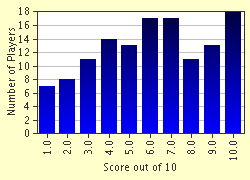Quiz Answer Key and Fun Facts
1. At the Battle of Lechfeld (Aug 9, 955 AD) the Magyars were defeated by the Saxons and forced to finally settle in Pannonia (modern Hungary). Which king of the Saxons ended the Magyar threat to Central Europe?
2. The Kingdom of Hungary was created when this duke was crowned king by Pope Sylvester II (Aug 15, 1000 AD). He established the Arpad dynasty which held the throne till 1301 AD. Which individual was it?
3. Andrew II, King of Hungary, was one of the few Christian monarchs to answer the call of Pope Honorius III for a new crusade in 1216 AD. Which Crusade did he participate in?
4. In Feb 1241 AD the Mongols of the Golden Horde descended into the Kingdom of Hungary after devastating Poland. Batu, the grandson of Genghis Khan, led the Mongols and defeated the Hungarian king at the Battle of the Mohi Bridge (on the Sajo River) (Apr 11, 1241 AD). Which king was it?
5. After the death of Andrew III in 1301 AD the Kingdom of Hungary was plunged into a civil war. Wenceslaus, King of Bohemia and King of Poland, briefly assumed the throne. The stuggle over the throne continued after his death and did not end till this individual was crowned in 1308 AD. Which individual was it?
6. The so-called 'Crusade' of Nicopolis (1396 AD) was proclaimed by Pope Boniface IX and would be the last great international movement in Christendom to try and stem the advance of the Ottoman Turks into central Europe and the Balkans. The 'Crusaders' were led by this king of Hungary (and future Holy Roman Emperor). Which individual was it?
7. At the Battle of Varna (Nov 10, 1444 AD) Ladislaus III, King of Hungary and King of Poland, was defeated and killed by the Ottoman Turks (led by Sultan Murad II). This famous Hungarian noble from Transylvania accompanied the king on campaign but managed to escape the disaster at Varna to continue the struggle with the Turks. His son would even become king of Hungary in 1458 AD. Which individual was it?
8. Between 1301-1458 AD the Kingdom of Hungary was ruled by kings of various foreign extractions (Polish, German, Bohemian, and Neopolitan). In 1458 AD this Hungarian assumed the throne and brought the kingdom to its height of power and prestige. Who was it?
9. At the Battle of Mohacs (Aug 29, 1526 AD) Louis II, King of Hungary and King of Bohemia, was defeated and killed by the Ottoman Turks under the command of the Sultan himself. Which Ottoman Sultan was it?
10. In 1526 AD the Austrian Hapsburg dynasty assumed the throne of Hungary which it held til 1918 AD. The first Hapsburg king was the brother of the Holy Roman emperor, Charles V. Which individual was it?
Source: Author
hund
This quiz was reviewed by FunTrivia editor
bloomsby before going online.
Any errors found in FunTrivia content are routinely corrected through our feedback system.

